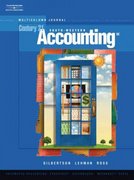Question
Question 1: Which would be more appropriate in each of the following situations job-order costing or process costing? Situation Job Order or Process Costing 1)
Question 1:
Which would be more appropriate in each of the following situations job-order costing or process costing?
| Situation | Job Order or Process Costing |
| 1) A golf course designer | |
| 2) A textbook publisher | |
| 3) A business consultant | |
| 4) An oil refinery | |
| 5) A soft-drink bottler | |
| 6) A film studio | |
| 7) A firm that supervises bridge construction projects | |
| 8) A manufacturer of fine custom jewelry | |
| 9) A paint factory | |
| 10) A factory making frozen orange juice concentrate |
Question 2:
R2D2 Test Systems manufactures automated testing equipment. The company uses a job-order costing system and applies overhead on the basis of machine hours (MH). At the beginning of the year, estimated manufacturing overhead was $1,960,000, and the estimated machine hours were 98,000. Data regarding several jobs at R2D2 are presented below.
| Job Number | Beginning Balance | Direct Materials | Direct Labour | Machine Hours |
| XJ-107 | $118,600 | $4,000 | $8,400 | 150 |
| ST-211 | 121,450 | 2,500 | 12,160 | 300 |
| XD-108 | 21,800 | 86,400 | 36,650 | 3,100 |
| SL-205 | 34,350 | 71,800 | 32,175 | 2,700 |
| RX-115 | 0 | 18,990 | 21,845 | 1,400 |
By the end of the first month (January), all jobs but RX-115 were completed, and all completed jobs had been delivered to customers except for SL-205. Required:
1) What was the balance in Finished Goods inventory at the end of January?
Question 3:
Takada Technology, Inc., has a job-order costing system. The company uses predetermined overhead rates in applying manufacturing overhead cost to individual jobs. The predetermined overhead rate in Department A is based on machine hours, and the rate in Department B is based on direct materials cost. At the beginning of the most recent year, the company's management made the following estimates for the year:
| Department A | Department B | |
| Machine-hours | 70,000 | 19,000 |
| Direct labour-hours | 30,000 | 60,000 |
| Direct materials cost | $195,000 | $282,000 |
| Direct labour cost | $260,000 | $520,000 |
| Manufacturing overhead cost | $420,000 | $705,000 |
Job 243 entered into production on April 1 and was completed on May 12. The company's cost records show the following information about the job:
| Department A | Department B | |
| Machine-hours | 250 | 60 |
| Direct labour-hours | 70 | 120 |
| Direct materials cost | $840 | $1,100 |
| Direct labour cost | $610 | $880 |
At the end of the year, the records of Takada showed the following actual cost and operating data for all jobs worked on during the year:
| Department A | Department B | |
| Machine-hours | 61,000 | 20,000 |
| Direct labour-hours | 28,000 | 66,000 |
| Direct materials cost | $156,000 | $284,000 |
| Manufacturing overhead cost | $385,000 | $705,000 |
Required:
- Compute the predetermined overhead rates for Department A and Department B.
- Compute the total overhead cost applied to Job 243.
- Compute the amount of underapplied or overapplied overhead in each department at the end of the current year.
Question 4:
Small Lake Fisheries, Inc. processes miscellaneous fish for various distributors. Two departments involved Cleaning and Packing. Data relating to kilograms of fish processed in the Cleaning department during May are given below:
| Kilograms of Fish | Percentage Completed | |
| WIP, May 1 | 15,000 | 55% |
| WIP, May 31 | 10,000 | 90% |
A total of 240,000 kilograms of fish were started into processing during May. All materials are added at the beginning of processing in the Cleaning Department.
Required:
- Compute the equivalent units for May for the Cleaning Department, assuming that the company uses the weighted-average method of accounting for units.
Question 5:
Grand Bend Company produces a high-quality insulation material that passes through two production processes. Data for November for the first process follow:
| Units | Completion with Respect to Materials | Completion with Respect to Conversion | |
| WIP, November 1 | 80,000 | 50% | 25% |
| WIP, November 30 | 60,000 | 45% | 20% |
| Totals | |
| Materials cost in WIP inventory, June 1 | $76,600 |
| Conversion cost in WIP inventory, June 1 | 34,900 |
| Units started into production | 300,000 |
| Units transferred to the next process | 320,000 |
| Materials costs added during June | 410,000 |
| Conversion cost added during June | 234,500 |
Required:
- Assume that the company uses the weighted-average method of accounting for units and costs. Determine the equivalent unit for November for the first process.
- Compute the costs per equivalent unit for November for the first process.
- Determine the total cost of ending work in process inventory and the total cost of units transferred to the next process in November.
Step by Step Solution
There are 3 Steps involved in it
Step: 1

Get Instant Access to Expert-Tailored Solutions
See step-by-step solutions with expert insights and AI powered tools for academic success
Step: 2

Step: 3

Ace Your Homework with AI
Get the answers you need in no time with our AI-driven, step-by-step assistance
Get Started


